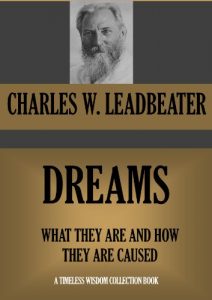Many of the subjects with which our theosophical studies bring us into contact are so far removed from the experiences and interests of everyday life, that while we feel drawn towards them by an attraction which increases in geometrical progression as we come to know more of them and understand them better, we are yet conscious, at the back of our minds, as it were, of a faint sense of unreality, or at least unpracticality, while we are dealing with them. When we read of the formation of the solar system, or even of the rings and rounds of our own planetary chain, we cannot but feel that, interesting though this is as an abstract study, useful as it is in showing us how man has become what we find him to be, it nevertheless associates itself only indirectly with the life we are living here and now.
No such objection as this, however, can be taken to our present subject: all readers of these lines have dreamed — probably many of them are in the habit of dreaming frequently; and they may therefore be interested in an endeavour to account for dream phenomena by the aid of the light thrown upon them by investigation along theosophic lines.
The most convenient method in which we can arrange the various branches of our subject will perhaps be the following: first, to consider rather carefully the mechanism — physical, etheric and astral — by means of which impressions are conveyed to our consciousness; secondly, to see how the consciousness in its turn affects and uses this mechanism; thirdly, to note the condition both of the consciousness and its mechanism during sleep; and fourthly, to enquire how the various kinds of dreams which men experience are thereby produced.
As I am writing in the main for students of theosophy, I shall feel myself at liberty to use, without detailed explanation, the ordinary theosophical terms, with which I may safely assume them to be familiar, since otherwise my little book would far exceed its allotted limits. Should it, however, fall into the hands of any to whom the occasional use of such terms constitutes a difficulty, I can only apologize to them, and refer them for these preliminary explanations to any elementary theosophical work, such as Mrs Besant's "The Ancient Wisdom", or "Man and his Bodies".
No such objection as this, however, can be taken to our present subject: all readers of these lines have dreamed — probably many of them are in the habit of dreaming frequently; and they may therefore be interested in an endeavour to account for dream phenomena by the aid of the light thrown upon them by investigation along theosophic lines.
The most convenient method in which we can arrange the various branches of our subject will perhaps be the following: first, to consider rather carefully the mechanism — physical, etheric and astral — by means of which impressions are conveyed to our consciousness; secondly, to see how the consciousness in its turn affects and uses this mechanism; thirdly, to note the condition both of the consciousness and its mechanism during sleep; and fourthly, to enquire how the various kinds of dreams which men experience are thereby produced.
As I am writing in the main for students of theosophy, I shall feel myself at liberty to use, without detailed explanation, the ordinary theosophical terms, with which I may safely assume them to be familiar, since otherwise my little book would far exceed its allotted limits. Should it, however, fall into the hands of any to whom the occasional use of such terms constitutes a difficulty, I can only apologize to them, and refer them for these preliminary explanations to any elementary theosophical work, such as Mrs Besant's "The Ancient Wisdom", or "Man and his Bodies".








